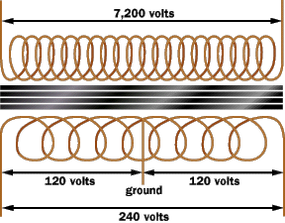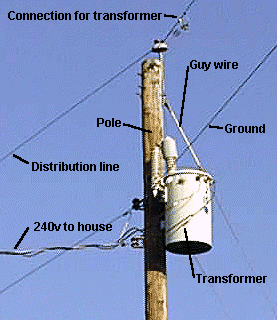Generating Power to Your House
And finally we are down to the wire that brings power to your house! Past a typical house runs a set of poles with one phase of power (at 7,200 volts) and a ground wire (although sometimes there will be two or three phases on the pole, depending on where the house is located in the distribution grid). At each house, there is a transformer drum attached to the pole.
In many suburban neighborhoods, the distribution lines are underground and there are green transformer boxes at every house or two.
Advertisement
The transformer's job is to reduce the 7,200 volts down to the 240 volts that makes up normal household electrical service. Let's look at this pole one more time, from the bottom, to see what is going on:
- Note there is a bare wire running down the pole. This is a grounding wire. Every utility pole on the planet has one. If you ever watch the power company install a new pole, you will see that the end of that bare wire is stapled in a coil to the base of the pole and therefore is in direct contact with the earth, running 6 to 10 feet (1.8 to 3 meters) underground. It is a good, solid ground connection. If you examine a pole carefully, you will see that the ground wire running between poles (and often the guy-wires coming from the sides) are attached to this direct connection to the ground.
- There are two wires running out of the transformer and three wires running to the house. The two from the transformer are insulated, and the third one is bare. The bare wire is the ground wire. The two insulated wires each carry 120 volts, but they are 180 degrees out of phase so the difference between them is 240 volts. This arrangement allows a homeowner to use both 120-volt and 240-volt appliances. The transformer is wired in this sort of configuration:

The 240 volts enters your house through a watt-hour meter, which measures your electrical consumption so the power company can charge you for putting up all of those wires. In the past, meter readers would periodically check your meter to record your usage. As part of the national upgrade to smart grid technology, millions of residential meters have now been replaced with smart meters that communicate directly with the power company. Not only can the utility read your meter remotely, but it is notified instantly in the case of a power outage, speeding recovery time [source: DOE].
